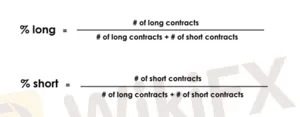简体中文
繁體中文
English
Pусский
日本語
ภาษาไทย
Tiếng Việt
Bahasa Indonesia
Español
हिन्दी
Filippiiniläinen
Français
Deutsch
Português
Türkçe
한국어
العربية
How to Read and Understand the COT Report
Abstract:Keep in mind that not every extreme of feeling corresponds to a market top or bottom, thus we'll need a more specific sign. Calculating the percentage of long or short speculative positions would be a better indicator of whether the market is topping or bottoming out.
What's next now that we've find out how to identify sentiment extremes?
Keep in mind that not every extreme of feeling corresponds to a market top or bottom, thus we'll need a more specific sign.
Calculating the percentage of long or short speculative positions would be a better indicator of whether the market is topping or bottoming out.
The formula for calculating percent -long and percent -short is as follows:

Let's look at what happened with Canadian dollar futures a few years ago to further understand this.
Speculators were net short 28,085 contracts according to COT statistics for the week ending August 22, 2008.
They were net short 23,950 contracts on March 20, 2009.
On the basis of this data, you may conclude that a market bottom is more possible in August because there were more speculators short at that time.
But wait. You didn't think it'd be that simple, did you?

A closer investigations reveals that 66,726 contracts were short, while 38,641 were long. In August, 63.3 percent of all speculative positions (66,726 / (38,641 + 66,726) were short positions.
In March, though, there were only 8,715 long contracts and 32,665 short contracts.
This suggests that all over that time period, 78.9% of the speculative positions were short (32,655 / (8,715 + 32,665). What exactly does this suggests?
When 78.9% of all speculative positions are short, a bottom is more possible to occur than when only 63.3 percent are short.
As you can see from the graph above, the bottom did not happen in August 2008, when the Canadian dollar was valued around 94 cents US.
Over the next few months, the Canadian dollar continued to plummet.
The Canadian dollar had struck a low around 77 U.S. cents by the time March rolled around and the percent-short ratio touched 78.9%.
So, what happened next? It began to increase steadily!
Is this the bottom of the market? Yes, you've found out!
Disclaimer:
The views in this article only represent the author's personal views, and do not constitute investment advice on this platform. This platform does not guarantee the accuracy, completeness and timeliness of the information in the article, and will not be liable for any loss caused by the use of or reliance on the information in the article.
Read more

Forex is a game that I enjoy playing
These champions have one thing in common: they not only work their butts off, but they also enjoy what they do.

Wait patiently. Maintain your discipline
"Patience is the key to everything," American comic Arnold H. Glasgow once quipped. The chicken is gotten by hatching the egg rather than crushing it."

There isn't a Holy Grail to be found!
Ask any Wall Street quant (the highly nerdy math and physics PhDs who build complicated algorithmic trading techniques) why there isn't a "holy grail" indicator, approach, or system that generates revenues on a regular basis.

Concentrate on the Process. Profits aren't a priority
We've designed the School of WikiFX as simple and enjoyable as possible to help you learn and comprehend the fundamental tools and best practices used by forex traders all over the world, but keep in mind that a tool or strategy is only as good as the person who uses it.
WikiFX Broker
Currency Calculator







